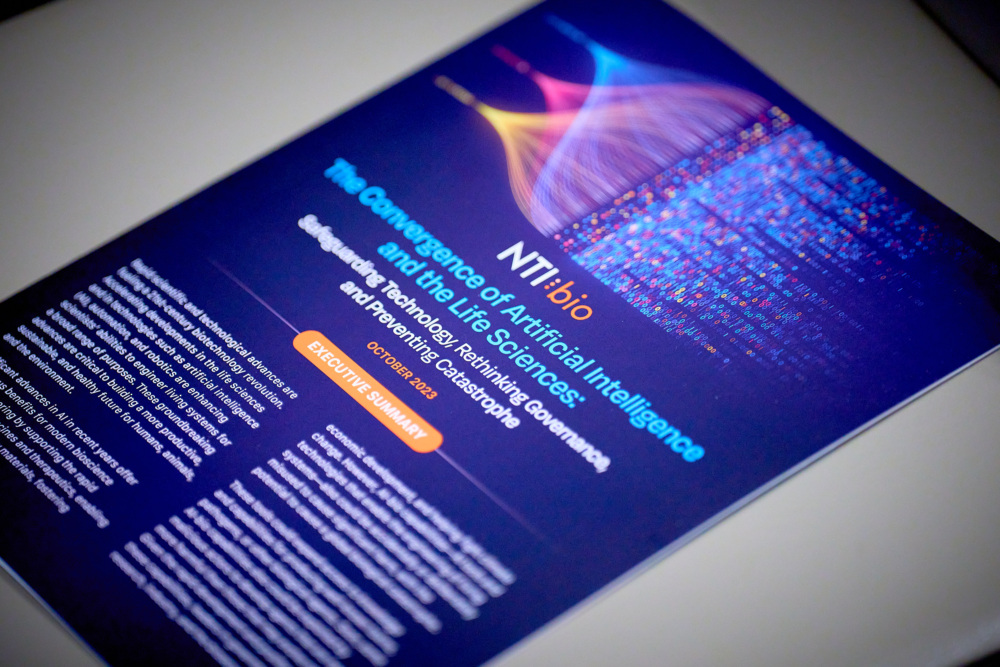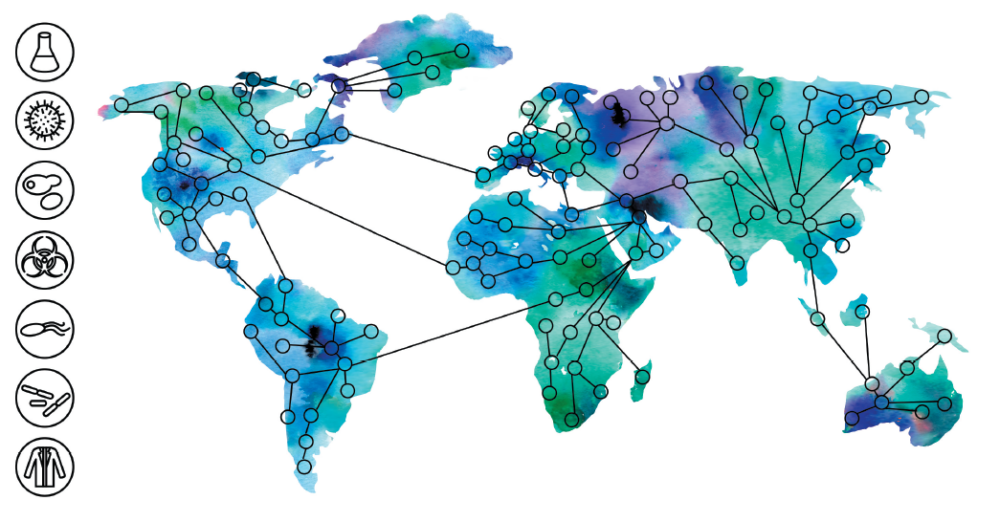
Jaime M. Yassif, Ph.D.
Vice President, Global Biological Policy and Programs
Testimony of Jaime M. Yassif, Ph.D.
Vice President, Global Biological Policy and Programs, Nuclear Threat Initiative
Before the U.S. House Select Subcommittee on the Coronavirus Pandemic
Hearing on “Strengthening Biosafety and Biosecurity Standards: Protecting Against Future Pandemics”
Wednesday, October 18, 2023
Chairman Wenstrup, Ranking Member Ruiz, and other members of the Subcommittee, thank you for the opportunity to join today’s hearing to share my perspective on Strengthening Biosafety and Biosecurity Standards: Protecting Against Future Pandemics. My name is Dr. Jaime Yassif. I serve as Vice President for Global Biological Policy and Programs at the Nuclear Threat Initiative (NTI), which is a nonprofit, nonpartisan global security organization focused on reducing nuclear and biological threats imperiling humanity.
I have 20 years of experience working at the interface of science, technology, public health, and international security within government and civil society. In my current role as NTI Vice President for Global Biological Policy and Programs, I oversee the organization’s work to reduce catastrophic biological risks, strengthen biosecurity and pandemic preparedness, and drive progress in advancing global health security. I previously served as a Program Officer at Open Philanthropy, where I led the Biosecurity and Pandemic Preparedness initiative, recommending and managing approximately $40 million in biosecurity grants, which rebuilt the field and supported work in several key areas. Prior to this, I served as a Science and Technology Policy Advisor at the U.S. Department of Defense and worked on the Global Health Security Agenda at the U.S. Department of Health and Human Services. I am a biophysicist by training, with a Ph.D. from UC Berkeley, as well as an MA in Science and Security from the King’s College London War Studies Department, and a BA in Biology from Swarthmore College.
The Global Biosafety and Biosecurity Challenge
We are experiencing a 21st century bioscience and biotechnology revolution. Accelerating bioscience and biotechnology advances are dramatically transforming capabilities to engineer living systems. New technologies create tremendous opportunities to benefit society, including by improving human health, supporting agriculture, fostering economic development, and combating climate change. However, these same advances also pose significant risks: that the tools of modern bioscience and biotechnology could be deliberately exploited by malicious actors or accidentally misused, which could lead to the next global biological catastrophe.
The world has seen the devastating effects of the COVID-19 pandemic in terms of loss of life, economic damage, and political disruption. The next pandemic could be as damaging as COVID-19—or potentially orders of magnitude worse. We should not assume that pandemics are a once in-a-century event. Pandemic risks are growing over time due to changes in trade and travel, urbanization, climate change, and new technologies that make it faster, easier, and cheaper to create and engineer pathogens.
As discussions continue to swirl about COVID-19 origins, the evidence as to whether it emerged naturally or resulted from an accident is so far inconclusive. We cannot say with confidence what the origins of COVID-19 are, but the fact that it is even plausible that so much disruption could have been caused by a possible laboratory accident is a big blinking red light. It signals the urgent need to strengthen biosafety and biosecurity – domestically and globally.
To set the stage, I’d like to offer some basic definitions of terms. The term “biosafety,” in thecontext of my testimony, refers to efforts to prevent lab accidents and accidental misuse ofbiology that could result in harm to humans, animals, and/or the environment. The term“biosecurity” refers to efforts to prevent the deliberate misuse of bioscience and biotechnologyto cause harm–i.e. to prevent the development and use of biological weapons. Both biosafetyand biosecurity are preventative by nature and are designed to safeguard bioscience andbiotechnology to prevent accidental or deliberate biological events.
When thinking about biosafety and biosecurity, it is useful to consider three broad categories of activities:
To protect the U.S. population here at home, and save lives globally—including friends, allies, and populations around the world—it is in our self-interest to take an international approach to bolstering biosafety and biosecurity. That’s because infectious diseases—no matter whether their origin is natural, accidental, or deliberate—do not respect borders.
Bolstering biosafety and biosecurity is critically important work, and it’s urgent. In the wake of COVID-19, the world has seen rapid international expansion of research into the SARS-CoV virus that caused the pandemic, as well as other pathogens with pandemic potential. This includes peacefully intended research to modify these pathogens or synthesize them from their genetic components. Much of this research is important for improving human health and for reducing future pandemic risks, including for advancing medical countermeasure development and improving biosurveillance capabilities. However, these developments are occurring amid the rapid construction of new high-containment labs to house this work, some of which may not have proper safety and security systems in place.
Biosafety and biosecurity provisions are very weak globally. According to the 2021 Global Health Security Index, which measures biosecurity and pandemic preparedness capacity across 195 countries, 91% of countries–that’s 178 countries in the world–score below 50 out of 100 points for biosecurity measures. This includes whole-of-government biosecurity systems, biosecurity training and practices, personnel vetting and regulating access to sensitive locations, secure and safe transport of infectious substances, and cross-border transfer and screening. Furthermore,126 countries are in the bottom tier for biosafety capacities—meaning they score 20 out of 100points or lower. Finally, governance of dual-use bioscience research is particularly weak in countries around the world; only 6% of countries have national-level oversight measures for dual-use research. The United States only scored 50 percent out of 100 on this measure, primarily because it has yet to legally require DNA synthesis screening.
Currently, there is no international entity that has its primary mission dedicated to reducing emerging biological risks associated with rapid technology advances and to safeguarding the life sciences by bolstering biosecurity and biosafety–notwithstanding the critically important work of the World Health Organization and the Biological Weapons Convention. International leadership and collaboration are essential for advancing promising approaches globally for biosafety and biosecurity. Bioscience governance gaps anywhere can leave the world vulnerable everywhere. This is something NTI is dedicated to changing, including through our upcoming launch of the International Biosecurity and Biosafety Initiative for Science (IBBIS), which is covered in greater detail later in my testimony.
Biden Administration Efforts to Advance Biosafety and Biosecurity in the U.S. and Abroad
I am very pleased that the Biden administration has taken a number of steps to bolster biosafety and biosecurity both domestically and internationally.
On the domestic front, the Administration just released updated guidance for DNA synthesis screening, which provides helpful improvements over the original guidance issued in 2010. This guidance is the only one of its kind in the world, and it is highly influential in shaping best practices of both U.S. and international DNA providers. The updated guidance includes recommendations for benchtop DNA synthesis device providers to conduct sequence and customer screening at the same standard as traditional DNA providers. Importantly, the new guidance also establishes baseline screening practices to make it possible for a wide range of DNA suppliers to comply, while also encouraging DNA providers to reach for a higher standard of biosecurity where possible. For example, the new guidance recommends that DNA providers improve upon baseline sequence screening practices by expanding the definition of “sequence of concern” beyond sequences found in regulated pathogens or toxins “as soon as it is practical to do so.” It is also helpful that the new guidance balances the need to advance best practices for DNA synthesis screening while providing flexibility for the DNA provider community where needed. In our conversations with colleagues in the DNA synthesis industry, we have heard that they welcome some form of regulation to establish shared ground rules and best practices in this rapidly evolving environment. While this is promising and important, DNA synthesis screening is still voluntary and not required—something Congress can and should change.
Another promising development is the January 2023 report from the National Science Advisory Board for Biosecurity (NSABB), titled “Proposed Biosecurity Oversight Framework for the Future of Science.” Huge congratulations are due to Dr. Gerry Parker–who is testifying along with me here today–and to his NSABB colleagues for producing such a forward-leaning set of recommendations for bolstering U.S. government oversight of dual-use bioscience research and for guarding against emerging biological risks associated with rapid technology advances. Now it will fall to the Administration and Congress to find practical, effective ways to implement these recommendations. For example, as a first step in implementing the recommendations put forth by the NSABB, the Office of Science and Technology Policy (OSTP) is working to update guidance on dual-use bioscience research of concern. OSTP recently issued a request for information from the broader bioscience and biosecurity communities about how to do this important work most effectively. The Administration has also issued a number of strategy documents and an executive order that address the domestic and international biosecurity landscape. These are outlined below.
The White House’s 2022 National Biodefense Strategy, issued last October, notes the importance of raising biosecurity and biosafety standards domestically and globally. The plan’s focus on preventing global biological catastrophe, including through efforts to strengthen biosecurity and biosafety, is crucial. In particular, improving governance of bioscience and biotechnology is essential to effectively guard against deliberate and accidental misuse with potentially catastrophic global consequences. NTI welcomes the inclusion of efforts to “galvanize support for multilateral biosafety and biosecurity commitments and the establishment of regional and global mechanisms to raise the global bar for biosafety and biosecurity norms and practices.” Given rapidly emerging biological risks that accompany science and technology advances, this work is critically important and urgent. The National Biodefense Strategy’s requirement that the National Security Council and the Office of Science and Technology Policy conduct an interagency policy review regarding biosafety and biosecurity norms and oversight for life sciences research also is valuable. As the largest funder of bioscience and biotechnology research and development in the world, the U.S. Government has a responsibility to put guardrails in place to prevent laboratory accidents or deliberate misuse of the tools of modern bioscience and biotechnology. Doing so can have a profound direct impact in reducing global biological risks and serve as a valuable example for other funders around the world.
In addition, the Executive Order on Advancing Biotechnology and Biomanufacturing Innovation for a Sustainable, Safe, and Secure American Bioeconomy includes an entire section on biosecurity and biosafety innovation. The Executive Order helpfully notes:
[W]e must take concrete steps to reduce biological risks associated with advances in biotechnology. We need to invest in and promote biosafety and biosecurity to ensure that biotechnology is developed and deployed in ways that align with United States principles and values and international best practices, and not in ways that lead to accidental or deliberate harm to people, animals, or the environment.
The Bioeconomy Executive Order also sets a requirement to launch a Biosafety and Biosecurity Innovation Initiative, to reduce biological risks associated with advances in biotechnology, biomanufacturing, and the bioeconomy, and it calls for priority investments in applied biosafety research and innovations in biosecurity to reduce biological risk throughout the biotechnology R&D and biomanufacturing lifecycles. This initiative doesn’t yet appear to be funded and should be fully implemented. The only way to get ahead of emerging biotechnology risks is to build biosecurity and biosafety into the grants, contracts, and awards we make to advance those technologies.
The Department of Defense Biodefense Posture Review, released this summer, also addresses this set of issues. It is encouraging that this strategy focuses on the need for innovative approaches to biosecurity that effectively reduce emerging biological risks associated with rapid scientific and technological advances. The establishment of a Biodefense Council designed to focus senior leadership attention within the Department on this issue is also a promising development.
The Work Ahead: Preventing Future Pandemics to Build a Safer World
Even with all the groundwork that has been laid, there is still more work ahead. Building a better system of biosafety and biosecurity safeguards for modern bioscience and biotechnology will require a layered defense–with practical and effective interventions at every step of the bioscience research and development lifecycle: from funding, through research execution, and on to publication or commercialization. For example, public and private funders who support bioscience research and innovation should incorporate more rigorous biosecurity review processes into their grant-making and investment decisions; this includes the U.S. Government as a major funder. At the same time, scientific journals should institute more rigorous prepublication review processes to ensure that they are not publishing “information hazards” that could lower the barrier for engineering a biological weapon. To be effective, these interventions will need to be broadly implemented in the U.S. and internationally, and they should evolve overtime to keep pace with rapid scientific and technological advances.
The U.S. government can take a number of concrete actions to work toward this vision and advance critical biosafety and biosecurity goals.
Bolstering biosafety and biosecurity domestically and internationally is extremely important work, and it’s urgent. The Biden Administration has made admirable progress in taking on this challenge, but most of the work lies ahead. If the U.S. government can achieve the biosafety and biosecurity goals it has set for itself–and work with partners in industry, academia, and civil society to foster the development of a biosafety and biosecurity innovation ecosystem–it will be a big win for reducing biological risks domestically and around the world. If not, the risk of facing another pandemic on the scale of COVID-19 or larger will grow, with even higher stakes as biological threats increase over time.
Chairman Wenstrup, Ranking Member Ruiz, and other members of the subcommittee, thank you for inviting me to testify today. I look forward to answering your questions.
Sign up for our newsletter to get the latest on nuclear and biological threats.
New report from NTI | bio offers recommendations for urgent actions that leaders within government, industry, the scientific community, and civil society should take to safeguard AI-bio capabilities.
Practical solutions for organizations involved in life science research to manage risks and prevent accidents, misuse, and other adverse outcomes stemming from their work.
In a new opinion piece for The Economist, Jaime Yassif makes the case for urgent action to create stronger guardrails for bioscience and biotechnology.


